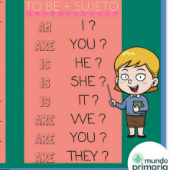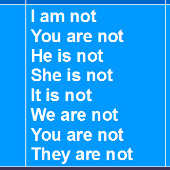VERBO TO BE – SER O ESTAR. El verbo TO BE, se traduce como SER O ESTAR, en el idioma inglés goza de Una particular importancia. Su significado Depende del sentido de la oración.


Examples: He is not listening music. My family is not at home. The pencil is not on the desk.
VERB TO BE EN INTERROGATIVO. Estructura: To be verb (Verbo to be: “is” en forma singular, o “are” en forma plural). + Subject (Sujeto, el cual puede ser un nombre propio o común o un artículo. + Complement (Complemento, resto de la oración). + Question mark(Signo de pregunta: ?)
VERB TO BE EN INTERROGATIVO. Estructura: To be verb (Verbo to be: “is” en forma singular, o “are” en forma plural). + Subject (Sujeto, el cual puede ser un nombre propio o común o un artículo. + Complement (Complemento, resto de la oración). + Question mark(Signo de pregunta: ?)

Examples: They are best friends. She is sleeping on her own bed. We are in the shopping center.
VERB TO BE EN AFIRMATIVO. Estructura: Subject (Sujeto, el cual puede ser un nombre propio o común o un artículo) + To be verb (Verbo to be: “is” en forma singular, o “are” en forma plural) + Complement (Complemento, resto de la oración).

Examples: He is not listening music. My family is not at home. The pencil is not on the desk.
Examples: Am I playing computer games right now? Is he a businessman? Is my family at home?
VERBO TO BE – SER O ESTAR. El verbo TO BE, se traduce como SER O ESTAR, en el idioma inglés goza de Una particular importancia. Su significado Depende del sentido de la oración.
Examples: They are best friends. She is sleeping on her own bed. We are in the shopping center.
Examples: Am I playing computer games right now? Is he a businessman? Is my family at home?
VERB TO BE EN NEGATIVO. Estructura: Subject (Sujeto, el cual puede ser un nombre propio o común o un artículo) + To be verb (Verbo to be: “is” en forma singular, o “are” en forma plural) + not + Complement (Complemento, resto de la oración).

VERB TO BE EN NEGATIVO. Estructura: Subject (Sujeto, el cual puede ser un nombre propio o común o un artículo) + To be verb (Verbo to be: “is” en forma singular, o “are” en forma plural) + not + Complement (Complemento, resto de la oración).
VERB TO BE EN AFIRMATIVO. Estructura: Subject (Sujeto, el cual puede ser un nombre propio o común o un artículo) + To be verb (Verbo to be: “is” en forma singular, o “are” en forma plural) + Complement (Complemento, resto de la oración).
